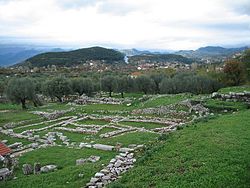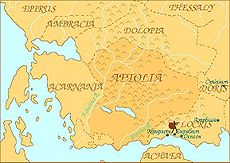- Aetolia
-
Aetolia
Αιτωλία
Ancient and modern Thermos, Aetolia Location: Western Greece Major cities: Thermos Dialects: Doric Key periods: Aetolian League
(290–189 BC)
Map of ancient Aetolia Aetolia is a mountainous region of Greece on the north coast of the Gulf of Corinth, forming the eastern part of the modern prefecture of Aetolia-Acarnania.
Contents
Geography
The Achelous River separates Aetolia from Acarnania to the west; on the north it had boundaries with Epirus and Thessaly; on the east with the Ozolian Locrians; and on the south the entrance to the Corinthian Gulf defined the limits of Aetolia.
In classical times Aetolia comprised two parts: Old Aetolia in the west, from the Achelous to the Evenus and Calydon; and New Aetolia or Acquired Aetolia in the east, from the Evenus and Calydon to the Ozolian Locrians. The country has a level and fruitful coastal region, but an unproductive and mountainous interior. The mountains contained many wild beasts, and acquired fame in Greek mythology as the scene of the hunt for the Calydonian Boar.
History
The peoples known as the Curetes and the Leleges originally inhabited the country, but at an early period Greeks from Elis, led by the mythical eponym Aetolus, set up colonies. Dionysius of Halicarnassus mentions that Curetes was the old name of the Aetolians and Leleges the old name of the Locrians.[1] The Aetolians took part in the Trojan War, under their king Thoas.
The Aetolians set up a united league, the Aetolian League, in early times. It soon became a powerful military confederation and by c. 340 BC it became one of the leading military powers in ancient Greece.[2] It had originally been organized during the reign of Philip II by the cities of Aetolia for their mutual benefit and protection and became a formidable rival to the Macedonian monarchs and the Achaean League. The League was one of the more effective political institutions that was produced in its time. In 279 BC a great mass of Gauls invaded mainland Greece, however they were repelled and driven out chiefly by the Aetolians.[3]
Dimitrios Makris(c. 1772–1841) a native of Aetolia was a Greek chief klepht, armatole, military commander and fighter of the 1821 Greek war of independence.
Unlike Achaea, there was a division between full members of the League and allies over which Aetolia maintained a hegemony. This did however allow Aetolia to maintain a much more genuine democracy and the bi-annual meetings of the League assembly coincided with games so that a far higher proportion of the citizens would have attended in person. The Aetolians took the side of Antiochus III against the Roman Republic, and on the defeat of that monarch in 189 BC, they became virtually the subjects of Rome. Following the conquest of the Achaeans by Lucius Mummius Achaicus in 146 BC, Aetolia became part of the Roman province of Achaea.
Aetolia's reputation has suffered from a rather hostile treatment in the sources. Polybius is considered now to have a heavy anti Aetolian bias due to his having relied on Aetolia's opponent Aratus of Achaea.
During the Middle Ages, Aetolia was part of the Byzantine Empire and later passed to the Turks : after a relatively unsuccessful attempt at colonization they took a token amount of slaves and resources from the region, then departed. See Ottoman Greece.
Aetolia was mentioned in Francisco Baltazar's Florante at Laura.
(This article incorporates material from Harry Thurston Peck's Harper's Dictionary of Classical Antiquities (1898).)
List of Aetolians
- Aitolos mythology
- Andraemon
- Thoas in Trojan War
- Titormus, wrestler
- Alexander Aetolus (ca.280 BC) poet
- Damocritus, general of Aetolian War
- Dorimachus, Aetolian general[4]
- Nicolaus of Aetolia Hellenistic general
- Theodotus of Aetolia Hellenistic general
- Pyrrhias stadion race Olympics 200 B.C[5] and Pyrrhias Aetolian general in Elis 218 BC[6]
- Agelaus of Naupactus 2nd c.BC
- Cosmas of Aetolia (1714–1779) monk
See also
- Aetolian League
- List of traditional Greek place names
- Aetolia Game
References
- ^ Dionysius of Halicarnassus, Roman Antiquities, Book 1, 1 at LacusCurtius [1]
- ^ "Aetolian League.". www.britannica.com. http://www.britannica.com/EBchecked/topic/7644/Aetolian-League. Retrieved 2010-09-10. "Aetolian League, federal state or “sympolity” of Aetolia, in ancient Greece. Probably based on a looser tribal community, it was well-enough organized to conduct negotiations with Athens in 367 BC. It became by c. 340 one of the leading military powers in Greece. Having successfully resisted invasions by Macedonia in 322 and 314–311, the league rapidly grew in strength during the ensuing period of Macedonian weakness, expanding into Delphi (centre of the Amphictyonic Council) and allying with Boeotia (c. 300). It was mainly responsible for driving out a major Gallic invasion of Greece in 279."
- ^ "Aetolian League.". www.britannica.com. http://www.britannica.com/EBchecked/topic/7644/Aetolian-League. Retrieved 2010-09-10. "Aetolian League, federal state or “sympolity” of Aetolia, in ancient Greece. Probably based on a looser tribal community, it was well-enough organized to conduct negotiations with Athens in 367 bc. It became by c. 340 one of the leading military powers in Greece. Having successfully resisted invasions by Macedonia in 322 and 314–311, the league rapidly grew in strength during the ensuing period of Macedonian weakness, expanding into Delphi (centre of the Amphictyonic Council) and allying with Boeotia (c. 300). It was mainly responsible for driving out a major Gallic invasion of Greece in 279."
- ^ [2]
- ^ Chronicon (Eusebius) 145th Olympiad
- ^ Smith, Dictionary of Greek and Roman Biography and Mythology Pyrrhias
Categories:- Aetolia
- Ancient Greek geography
Wikimedia Foundation. 2010.


